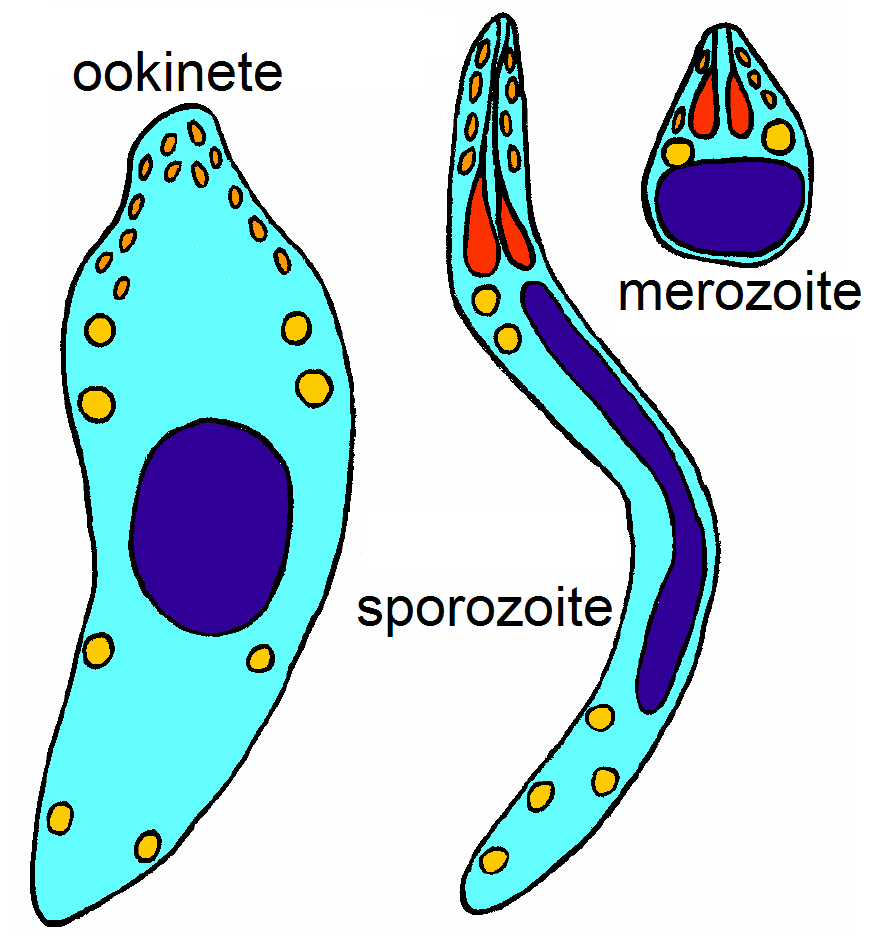Reproduction
Over the past couple of years Babesia canis has undergone much research, which has led to further understanding of the life cycle and characteristics of B. canis. B. canis’s life cycle is now relatively understood, though some discrepancies are present, including that B. canis has multiple haploid gametic stages within its life cycle. B. canis reproduces differently depending on whether it is in a vertebrate host, or an invertebrate vector (normally a tick). In fact B. canis’s life cycle can be split between its life in a canine, and its life in a vector.
Lifecycle of B. canis in the canine host
B. canis
development within its host is rather different then its development
within its vector. B. canis is first introduced in the form of
sporozoites to its host via the salivary gland of the tick during a
blood meal. If B. canis is not in sporozoite form the transmission
of B. canis a failure (Melhorn a nd Schein 1984). Fortunately a
tick’s bite, unlike that of a mosquito bite can last anywhere from
two days to two weeks. This increase in time allows for an extensive
amount of B. canis sporozoites to be introduced to the vertebrate
host’s erythrocytes.
nd Schein 1984). Fortunately a
tick’s bite, unlike that of a mosquito bite can last anywhere from
two days to two weeks. This increase in time allows for an extensive
amount of B. canis sporozoites to be introduced to the vertebrate
host’s erythrocytes.
After the sporozoite has penetrated the cell wall of the erythrocyte, B. canis will reproduce asexually (Gorenflot et al. 1991). B. canis does this through binary fission, and will create merozoites as a product (Melhorn and Schein 1984). This will continue to occur until the erythrocyte cell ruptures (or lysis). These merozoites will then invade other host erythrocytes; a couple may mature into sporozoites and repeat the process (Gorenflot et al. 1991). This form of reproduction is asynchronous, meaning that B. canis can be found reproducing at various times within its lifecycle while within the host’s bloodstream. (Chauvin et al. 2009).
To learn more about other hosts used by the genus Babesia check out these pages- Domestic Cow and Horse.
Size
Size of the
merozoites is dependent upon the subspecies of B. canis as well as
the kind of host species. B. canis has two sizes: large and small.
Large merozoites are characterized as being larger then the radius
of the host erythrocyte. Small merozoites are characterized as being
smaller then the radius of the host erythrocyte (Gorenflot et al.
1991).
Lifecycle of B. canis in the tick vector
B. canis life
cycle within the tick vector is much more complex. Ticks will
receive B. canis via ingestion of erythrocytes from a vertebrate
host. At this point only sporozoites will survive the transmission
and all other stages will be destroyed. Once ingested, B. canis
sporozoites develop into gametocytes rather than merozoites. These
gametocytes have elongated bodies and arrowhead shaped rays that
develop at the head of the gametocyte (Gorenflot et al. 1991).
Gametocytes will then fuse with the tick’s digestive tract,
specifically the lumen. At this point the gamete will form via
sexual, or asexual replication into a zygote that is approximately
8-10 nanometers in length. The zygote will also develop an arrowhead
shaped organelle used for further penetration (Mackenstedt et al.
1995).
The zygote will then continue penetrating into the digestive
tract into whi ch it will release enzymes that will lyse the point of
entry into the digestive tract. The Arrowhead shaped organelle will
disintegrate, allowing the zygote to undergo meiosis into four
ookinetes. Ookinets are haploid and are much more motile then the
previous zygote. The Ookinets will leave the digestive tract and
will begin invading other tick tissue. If by chance the tick is a
female, ookinetes will infect the eggs, causing them to become
vectors, this process is called “transovarial transmission”. B.
canis will undergo asexual reproduction, creating sporokinetes. If
kinetes (sporokinete, or ookinets) invade the salivary gland of the
tick, a final stage of development will take place in which the
kinetes will produce sporozoites. Sporozoites are the transmittable
stage of the B. canis life cycle, which can be spread to vertebrate
hosts via tick bite (Melhorn and Schein 1984, Schein et al. 1980).
ch it will release enzymes that will lyse the point of
entry into the digestive tract. The Arrowhead shaped organelle will
disintegrate, allowing the zygote to undergo meiosis into four
ookinetes. Ookinets are haploid and are much more motile then the
previous zygote. The Ookinets will leave the digestive tract and
will begin invading other tick tissue. If by chance the tick is a
female, ookinetes will infect the eggs, causing them to become
vectors, this process is called “transovarial transmission”. B.
canis will undergo asexual reproduction, creating sporokinetes. If
kinetes (sporokinete, or ookinets) invade the salivary gland of the
tick, a final stage of development will take place in which the
kinetes will produce sporozoites. Sporozoites are the transmittable
stage of the B. canis life cycle, which can be spread to vertebrate
hosts via tick bite (Melhorn and Schein 1984, Schein et al. 1980).
To learn more about another parasite that effects the blood cell of another organism check out Plasmodium falciparum the parasite that just will not quit.
Continue on to Babesia canis's interactions with other species! Home
